Paving with Precast Concrete Made with Recycled Mixed Ceramic Aggregates: A Viable Technical Option for the Valorization of Construction and Demolition Wastes (CDW)
Abstract
:1. Introduction
2. Materials and Methods
2.1. Concrete Raw Materials
2.2. Concrete Mix Proportions
2.3. Non-Structural Precast Concrete Elements
2.4. Tests
2.4.1. Consistency
2.4.2. Density
2.4.3. Surface Finish and Dimensions
2.4.4. Compressive Strength
2.4.5. Flexural Strength of Curbstones
2.4.6. Splitting Tensile Strength of Paving Blocks
2.4.7. Microstructure
2.4.8. Porosity
2.4.9. Water Absorption
2.4.10. Abrasion Test
2.4.11. Freeze–Thaw Test
2.4.12. Electrical Resistivity
3. Results and Discussion
3.1. Consistency and Density
3.2. Surface Finish and Dimensions
3.3. Mechanical Properties
3.3.1. Compressive Strength
3.3.2. Flexural Strength of Curbstones
3.3.3. Splitting Tensile Strength of Paving Blocks
3.3.4. Microstructure
3.4. Durability Properties
3.4.1. Porosity
3.4.2. Water Absorption
3.4.3. Abrasion Test
3.4.4. Freeze–Thaw Test
3.4.5. Electrical Resistivity
4. Conclusions
- The use of recycled concrete, made with up to a 50% substitution of the natural coarse aggregates by RMAc aggregates, does not affect the general behavior of the concrete. In particular, it is worth mentioning the durability performance reached by the recycled concrete, which was able to comply with the requirements established in the standards for curbstones and paving blocks.
- The effects of a 50% RMAc incorporation on the workability and density of concrete were acceptable, despite resulting in drier consistencies and lower densities.
- The recycled concrete presented a good superficial finish, and a texture and colour comparable to the industrially produced specimens.
- The mechanical resistances were the properties most affected by the partial substitution. Although samples complied with the requirements set forth in the standards, decreases in the compressive and flexural strength were observed. Nevertheless, the splitting tensile strength displayed by the recycled paving blocks was barely affected by the substitution, and showed similar values to those obtained by the conventional concrete.
- The SEM, backscattered-electron (BSE) and MIP analysis revealed that a 3 min RMAc pre-saturation effectively palliated their greater water absorption, and thus, a good cement hydration was achieved within the recycled paste. Moreover, an adequate covering effect of the cement paste around the ceramic recycled aggregates was observed, and the thickness of the ITZ between recycled aggregates and cement paste indicated an improved bond compared to the interface developed around the natural aggregates.
- The indirect measure of compactness, evaluated by the electrical resistivity of the samples, revealed that both concretes presented a similar behavior.
- The results regarding the durability of the recycled concrete, which was evaluated through different tests: water absorption, abrasion, and a freeze–thaw test, showed that the major effect was that noticed for water absorption, which surpassed the limit established in the standards (6%) and reached values of 8% and 9% for blocks and curbstones, respectively. Despite this drawback, it was possible to ascertain that the abrasion and freeze–thaw resistance of the conventional and recycled concrete was similar, even slightly better in the recycled concrete.
Author Contributions
Funding
Acknowledgments
Conflicts of Interest
References
- Ecoembes. Presentación de Resultados 2017. Available online: https://www.ecoembes.com/sites/default/files/reciclaje-en-datos-2017.pdf (accessed on 12 December 2018).
- Eurostat. Waste Statistics—Statistics Explained. 2016. Available online: http://ec.europa.eu/eurostat/statistics-explained/index.php/Waste_statistics (accessed on 26 June 2018).
- Spanish Ministry of Environment. Resolución de 14 de Junio de 2001, de la Secretaría General de Medio Ambiente, por la que se Dispone la Publicación del Acuerdo de Consejo de Ministros, de 1 de Junio de 2001, por el que se Aprueba el Plan Nacional de Residuos de Construcción y Demolición [WWW Document]. BOE Núm. 166 12 Julio. 2001. Available online: http://noticias.juridicas.com/base_datos/Admin/res140601-1-mma.html (accessed on 20 June 2018).
- Bravo, M.; de Brito, J.; Evangelista, L.; Pacheco, J. Superplasticizer’s efficiency on the mechanical properties of recycled aggregates concrete: Influence of recycled aggregates composition and incorporation ratio. Constr. Build. Mater. 2017, 153, 129–138. [Google Scholar] [CrossRef]
- Bravo, M.; de Brito, J.; Pontes, J.; Evangelista, L. Shrinkage and creep performance of concrete with recycled aggregates from CDW plants. Mag. Concr. Res. 2017, 69, 974–995. [Google Scholar] [CrossRef]
- Kurda, R.; de Brito, J.; Silvestre, J.D. Water absorption and electrical resistivity of concrete with recycled concrete aggregates and fly ash. Cem. Concr. Compos. 2019, 95, 169–182. [Google Scholar] [CrossRef]
- Kurda, R.; Silvestre, J.D.; de Brito, J. Life cycle assessment of concrete made with high volume of recycled concrete aggregates and fly ash. Resour. Conserv. Recycl. 2018, 139, 407–417. [Google Scholar] [CrossRef]
- Pedro, D.; de Brito, J.; Evangelista, L. Durability performance of high-performance concrete made with recycled aggregates, fly ash and densified silica fume. Cem. Concr. Compos. 2018, 93, 63–74. [Google Scholar] [CrossRef]
- Carro-López, D.; González-Fonteboa, B.; Martínez-Abella, F.; González-Taboada, I.; de Brito, J.; Varela-Puga, F. Proportioning, fresh-state properties and rheology of self-compacting concrete with fine recycled aggregates. Hormig. Acero 2018, 69, 213–221. [Google Scholar] [CrossRef]
- Jankovic, K.; Nikolic, D.; Bojovic, D. Concrete paving blocks and flags made with crushed brick as aggregate. Constr. Build. Mater. 2012, 28, 659–663. [Google Scholar] [CrossRef]
- López Gayarre, F.; López-Colina, C.; Serrano, M.A.; López-Martínez, A. Manufacture of Concrete Kerbs and Floor Blocks with Recycled Aggregate from C&DW. Constr. Build. Mater. 2013, 40, 1193–1199. [Google Scholar]
- Poon, C.S.; Chan, D. Paving blocks made with recycled concrete aggregate and crushed clay brick. Constr. Build. Mater. 2006, 20, 569–577. [Google Scholar] [CrossRef]
- Poon, C.S.; Chan, D. Effects of contaminants on the properties of concrete paving blocks prepared with recycled concrete aggregates. Constr. Build. Mater. 2007, 21, 164–175. [Google Scholar] [CrossRef]
- Rodríguez, C.; Parra, C.; Casado, G.; Miñano, I.; Albaladejo, F.; Benito, F.; Sánchez, I. The incorporation of construction and demolition wastes as recycled mixed aggregates in non-structural concrete precast pieces. J. Clean. Prod. 2016, 127, 152–161. [Google Scholar] [CrossRef] [Green Version]
- Sadek, W.; El-Sayed, A.; Heniegal, A.M. Production of solid cemente bricks using some types of solid wastes. Eng. Res. J. 2013, 138, 1–15. [Google Scholar]
- Soutsos, M.N.; Tang, K.; Millard, S.G. Use of recycled demolition aggregate in precast products, phase II: Concrete paving blocks. Constr. Build. Mater. 2011, 25, 3131–3143. [Google Scholar] [CrossRef]
- Soutsos, M.N.; Tang, K.; Millard, S.G. Concrete building blocks made with recycled demolition aggregate. Constr. Build. Mater. 2011, 25, 726–735. [Google Scholar] [CrossRef]
- Juan-Valdés, A.; Rodríguez-Robles, D.; García-González, J.; Guerra-Romero, M.I.; Morán-del Pozo, J.M. Mechanical and microstructural characterization of non-structural precast concrete made with recycled mixed ceramic aggregates from construction and demolition wastes. J. Clean. Prod. 2018, 180, 482–493. [Google Scholar] [CrossRef]
- Anon. Guía Española de Áridos Reciclados Procedentes de Residuos de Construcción y Demolición; Fueyo Editores: Madrid, Spain, 2012. [Google Scholar]
- RC-16. Royal Decree 256, Cement Reception Instruction (RC-16); Ministry of Public Works: Madrid, Spain, 2016. (In Spanish) [Google Scholar]
- EN 197-1. Cement Part 1: Composition, Specifications and Conformity Criteria for Common Cements; CEN: Brussels, Belgium, 2011. [Google Scholar]
- Mas, B.; Cladera, A.; Bestard, J.; Muntaner, D.; López, C.E.; Piña, S.; Prades, J. Concrete with mixed recycled aggregates: Influence of the type of cement. Constr. Build. Mater. 2012, 34, 430–441. [Google Scholar] [CrossRef]
- EHE-08. Code on Structural Concrete (EHE-08); Spanish Ministry of Public Works: Madrid, Spain, 2008. (In Spanish) [Google Scholar]
- EN 12620+A1. Aggregates for Concrete; CEN: Brussels, Belgium, 2008. [Google Scholar]
- EN 933-1. Tests for Geometrical Properties of Aggregates—Part 1: Determination of Particle Size Distribution—Sieving Method; CEN: Brussels, Belgium, 2012. [Google Scholar]
- EN 933-3. Tests for Geometrical Properties of Aggregates—Part 3: Determination of Particle Shape—Flakiness Index; CEN: Brussels, Belgium, 2012. [Google Scholar]
- EN 1097-2. Tests for Mechanical and Physical Properties of Aggregates—Part 2: Methods for the Determination of Resistance to Fragmentation; CEN: Brussels, Belgium, 2010. [Google Scholar]
- EN 1097-6. Tests for Mechanical and Physical Properties of Aggregates—Part 6: Determination of Particle Density and Water Absorption; CEN: Brussels, Belgium, 2013. [Google Scholar]
- Abbas, A.; Fathifazl, G.; Burkan Isgor, O.; Razaqpur, A.G.; Fournier, B.; Foo, S. Proposed Method for Determining the Residual Mortar Content of Recycled Concrete Aggregates. J. ASTM Int. 2008, 5, 101087. [Google Scholar]
- Shi, C.; Li, Y.; Zhang, J.; Li, W.; Chong, L.; Xie, Z. Performance enhancement of recycled concrete aggregate—A review. J. Clean. Prod. 2016, 112, 466–472. [Google Scholar] [CrossRef]
- Tam, V.W.Y.; Tam, C.M.; Le, K.N. Removal of cement mortar remains from recycled aggregate using pre-soaking approaches. Resour. Conserv. Recycl. 2007, 50, 82–101. [Google Scholar] [CrossRef]
- Zhang, J.; Shi, C.; Li, Y.; Pan, X.; Poon, C.-S.; Xie, Z. Influence of carbonated recycled concrete aggregate on properties of cement mortar. Constr. Build. Mater. 2015. [Google Scholar] [CrossRef]
- Zhang, J.; Shi, C.; Li, Y.; Pan, X.; Poon, C.-S.; Xie, Z. Performance Enhancement of Recycled Concrete Aggregates through Carbonation. J. Mater. Civ. Eng. 2015, 27, 04015029. [Google Scholar] [CrossRef]
- Poon, C.S.; Chan, D. Feasible use of recycled concrete aggregates and crushed clay brick as unbound road sub-base. Constr. Build. Mater. 2006, 20, 578–585. [Google Scholar] [CrossRef]
- Yang, J.; Du, Q.; Bao, Y. Concrete with recycled concrete aggregate and crushed clay bricks. Constr. Build. Mater. 2011, 25, 1935–1945. [Google Scholar] [CrossRef]
- García-González, J.; Rodríguez-Robles, D.; Juan-Valdés, A.; Morán-del Pozo, J.; Guerra-Romero, M.I. Pre-Saturation Technique of the Recycled Aggregates: Solution to the Water Absorption Drawback in the Recycled Concrete Manufacture. Materials 2014, 7, 6224–6236. [Google Scholar] [CrossRef] [PubMed] [Green Version]
- EN 933-11. Tests for Geometrical Properties of Aggregates—Part 11: Classification Test for the Constituents of Coarse Recycled Aggregate; CEN: Brussels, Belgium, 2009. [Google Scholar]
- Neville, A.M. Properties of Concrete; Longman: Harlow, UK, 1995. [Google Scholar]
- De Guzmán Báez, A. Study of the Fundamental Properties of Prefabricated Non-Structural Concrete Elements Incorporating Recycled Aggregate in Their Coarse and Fine Fraction; E.U. de Arquitectura Técnica (UPM): Madrid, Spain, 2010. [Google Scholar]
- Poon, C.S.; Kou, S.C.; Lam, L. Use of recycled aggregates in molded concrete bricks and blocks. Constr. Build. Mater. 2002, 16, 281–289. [Google Scholar] [CrossRef]
- Poon, C.; Shui, Z.; Lam, L. Effect of microstructure of ITZ on compressive strength of concrete prepared with recycled aggregates. Constr. Build. Mater. 2004, 18, 461–468. [Google Scholar] [CrossRef]
- Poon, C.S.; Shui, Z.H.; Lam, L.; Fok, H.; Kou, S.C. Influence of moisture states of natural and recycled aggregates on the slump and compressive strength of concrete. Cem. Concr. Res. 2004, 34, 31–36. [Google Scholar] [CrossRef]
- EN 127340. Concrete Kerb Units. Requirements and Test Methods; National Complement to the Standard EN 1340: Madrid, Spain, 2006. [Google Scholar]
- EN 12390-1. Testing Hardened Concrete—Part 1: Shape, Dimensions and Other Requirements for Specimens and Moulds; CEN: Brussels, Belgium, 2012. [Google Scholar]
- EN 12390-2. Testing Hardened Concrete—Part 2: Making and Curing Specimens for Strength Tests; CEN: Brussels, Belgium, 2009. [Google Scholar]
- EN 12350-3. Testing Fresh Concrete—Part 3: Vebe Test; CEN: Brussels, Belgium, 2009. [Google Scholar]
- EN 12350-1. Testing Fresh Concrete—Part 1: Sampling; CEN: Brussels, Belgium, 2009. [Google Scholar]
- EN 12390-7. Testing Hardened Concrete—Part 7: Density of Hardened Concrete; CEN: Brussels, Belgium, 2009. [Google Scholar]
- EN 1340. Concrete Kerb Units—Requirements and Test Methods; CEN: Brussels, Belgium, 2003. [Google Scholar]
- EN 1340/AC. Concrete Kerb Units. Requirements and Test Methods; National Complement to the Standard EN 1340: Madrid, Spain, 2006. [Google Scholar]
- EN 1338. Concrete Paving Blocks—Requirements and Test Methods; CEN: Brussels, Belgium, 2003. [Google Scholar]
- EN 12390-3/AC. Testing Hardened Concrete—Part 3: Compressive Strength of Test Specimens; CEN: Brussels, Belgium, 2011. [Google Scholar]
- EN 12390-4. Testing Hardened Concrete—Part 4: Compressive Strength—Specification for Testing Machines; CEN: Brussels, Belgium, 2000. [Google Scholar]
- EN 83988-1. Concrete Durability. Test Methods. Determination of the Electrical Resistivity. Part 1: Direct Test (Reference Method); AENOR: Madrid, Spain, 2008. [Google Scholar]
- Xiao, Z.; Ling, T.C.; Kou, S.C.; Wang, Q.; Poon, C.S. Use of wastes derived from earthquakes for the production of concrete masonry partition wall blocks. Waste Manag. 2011, 31, 1859–1866. [Google Scholar] [CrossRef] [PubMed]
- Medina, C.; Zhu, W.; Howind, T.; Frías, M.; Sánchez de Rojas, M.I. Effect of the constituents (asphalt, clay materials, floating particles and fines) of construction and demolition waste on the properties of recycled concretes. Constr. Build. Mater. 2015, 79, 22–33. [Google Scholar] [CrossRef] [Green Version]
- Medina, C.; Zhu, W.; Howind, T.; Sánchez de Rojas, M.I.; Frías, M. Influence of mixed recycled aggregate on the physical—Mechanical properties of recycled concrete. J. Clean. Prod. 2014, 68, 216–225. [Google Scholar] [CrossRef]
- Rodríguez-Robles, D.; García-González, J.; Juan-Valdés, A.; Morán-del Pozo, J.M.; Guerra-Romero, M.I. Effect of mixed recycled aggregates on mechanical properties of recycled concrete. Mag. Concr. Res. 2015, 67, 247–256. [Google Scholar] [CrossRef]
- Gonzalez-Corominas, A.; Etxeberria, M. Properties of high performance concrete made with recycled fine ceramic and coarse mixed aggregates. Constr. Build. Mater. 2014, 68, 618–626. [Google Scholar] [CrossRef]
- Shaikh, F.U.A.; Nguyen, H.L. Properties of concrete containing recycled construction and demolition wastes as coarse aggregates. J. Sustain. Cem. Mater. 2013, 2, 204–217. [Google Scholar] [CrossRef]
- Özalp, F.; Yılmaz, H.D.; Kara, M.; Kaya, Ö.; Şahin, A. Effects of recycled aggregates from construction and demolition wastes on mechanical and permeability properties of paving stone, kerb and concrete pipes. Constr. Build. Mater. 2016, 110, 17–23. [Google Scholar] [CrossRef]
- Sidorova, A.; Vazquez-Ramonich, E.; Barra-Bizinotto, M.; Roa-Rovira, J.J.; Jimenez-Pique, E. Study of the recycled aggregates nature’s influence on the aggregate–cement paste interface and ITZ. Constr. Build. Mater. 2014, 68, 677–684. [Google Scholar] [CrossRef]
- Tam, V.W.Y.; Gao, X.F.; Tam, C.M. Microstructural analysis of recycled aggregate concrete produced from two-stage mixing approach. Cem. Concr. Res. 2004, 35, 1195–1203. [Google Scholar] [CrossRef]
- Ferreira, L.; De Brito, J.; Barra, M. Influence of the pre-saturation of recycled coarse concrete aggregates on concrete properties. Mag. Concr. Res. 2011, 63, 617–627. [Google Scholar] [CrossRef]
- Mefteh, H.; Kebaïli, O.; Oucief, H.; Berredjem, L.; Arabi, N. Influence of moisture conditioning of recycled aggregates on the properties of fresh and hardened concrete. J. Clean. Prod. 2013, 54, 282–288. [Google Scholar] [CrossRef]
- Binici, H.; Arocena, J.; Kapur, S.; Aksogan, O.; Kaplan, H. Microstructure of red brick dust and ground basaltic pumice blended cement mortars exposed to magnesium sulphate solutions. Can. J. Civ. Eng. 2009, 36, 1784–1793. [Google Scholar] [CrossRef]
- Henocq, P.; Samson, E.; Marchand, J. Portlandite content and ionic transport properties of hydrated C3S pastes. Cem. Concr. Res. 2012, 42, 321–326. [Google Scholar] [CrossRef]
- Lee, K.-H.; Yang, K.-H. Development of a neutral cementitious material to promote vegetation concrete. Constr. Build. Mater. 2016, 127, 442–449. [Google Scholar] [CrossRef]
- Poon, C.-S.; Kou, S.; Wan, H.; Etxeberria, M. Properties of concrete blocks prepared with low grade recycled aggregates. Waste Manag. 2009, 29, 2369–2377. [Google Scholar] [CrossRef] [PubMed]
- Rigo da Silva, C.A.; Pedrosa Reis, R.J.; Soares Lameiras, F.; Vasconcelos, W.L. Carbonation-Related Microstructural Changes in Long-Term Durability Concrete. Mater. Res. 2002, 5, 287–293. [Google Scholar] [CrossRef]
- Hewlett, P. Lea’s Chemistry of Cement and Concrete; Elsevier: Amsterdam, The Netherlands, 2003. [Google Scholar]
- Malhotra, V.M.; Mehta, P.K. Puzzolanic and Cementitious Materials; Taylor and Francis: London, UK, 1996. [Google Scholar]
- Mindess, S.; Young, J.F.; Darwing, D. Concrete; Prentice Hall: Upper Saddle River, NJ, USA, 2003. [Google Scholar]
- Gómez-Soberón, J.M.V. Porosity of recycled concrete with substitution of recycled concrete aggregate: An experimental study. Cem. Concr. Res. 2002, 32, 1301–1311. [Google Scholar] [CrossRef]
- Bermejo, E.B.; Moragues, A.; Gálvez, J.C.; Fernández Cánovas, M. Permeability and pore size distribution in medium strength self-compacting concrete. Materiales de Construcción 2010, 60, 37–51. [Google Scholar]
- Kumar, R.; Bhattacharjee, B. Porosity, pore size distribution and in situ strength of concrete. Cem. Concr. Res. 2003, 33, 155–164. [Google Scholar] [CrossRef]
- Moon, D.J.; Moon, H.Y. Effect of Pore Size Distribution on the Qualities of Recycled Aggregate Concrete. KSCE J. Civ. Eng. 2002, 6, 289–295. [Google Scholar] [CrossRef]
- Cortas, R.; Rozière, E.; Staquet, S.; Hamami, A.; Loukili, A.; Delplancke-Ogletree, M.-P. Effect of the water saturation of aggregates on the shrinkage induced cracking risk of concrete at early age. Cem. Concr. Compos. 2014. [Google Scholar] [CrossRef]
- Buyle-Bodin, F.; Hadjieva-Zaharieva, R. Influence of industrially produced recycled aggregates on flow properties of concrete. Mater. Struct. 2002, 35, 504–509. [Google Scholar] [CrossRef]
- Kou, S.-C.; Poon, C.-S.; Etxeberria, M. Influence of recycled aggregates on long term mechanical properties and pore size distribution of concrete. Cem. Concr. Compos. 2011, 33, 286–291. [Google Scholar] [CrossRef]
- Rübner, K.; Kühne, H.C. Pore Structure of Concrete with Recycing Aggregates. In 33o International Geologogical Congress; The Charlesworth Group: Wakefield, UK, 2008. [Google Scholar]
- Guo, Y.; Qian, J.; Wang, X. Pore Structure and Influence of Recycled Aggregate Concrete on Drying Shrinkage. Math. Probl. Eng. 2013. [Google Scholar] [CrossRef]
- Medina, C.; Frías, M.; Sánchez de Rojas, M.I. Microstructure and properties of recycled concretes using ceramic sanitary ware industry waste as coarse aggregate. Constr. Build. Mater. 2012, 31, 112–118. [Google Scholar] [CrossRef]
- Soutsos, M.N.; Tang, K.; Millard, S.G. The use of recycled demolition aggregate in precast concrete products—Phase III: Concrete pavement flags. Constr. Build. Mater. 2012, 36, 674–680. [Google Scholar] [CrossRef]
- Olorunsogo, F.; Padayachee, N. Performance of recycled aggregate concrete monitored by durability indexes. Cem. Concr. Res. 2002, 32, 179–185. [Google Scholar] [CrossRef]
- Wirquin, E.; Hadjieva-Zaharieva, R.; Buyle-Bodin, F. Use of water absorption by concrete as a criterion of the durability of concrete-application to recycled aggregated concrete. Mater. Struct. 2000, 33, 403–408. [Google Scholar] [CrossRef]
- Pacheco-Torgal, F.; Jalali, S. Compressive strength and durability properties of ceramic wastes based concrete. Mater. Struct. 2011, 44, 155–167. [Google Scholar] [CrossRef]
- Gencel, O.; Ozel, C.; Koksal, F.; Erdogmus, E.; Martínez-Barrera, G.; Brostow, W. Properties of concrete paving blocks made with waste marble. J. Clean. Prod. 2012, 21, 62–70. [Google Scholar] [CrossRef]
- Sadek, D.M.; El Nouhy, H.A. Properties of paving units incorporating crushed ceramic. HBRC J. 2014, 10, 198–205. [Google Scholar] [CrossRef]
- Mas, B.; Cladera, A.; del Olmo, T.; Pitarch, F. Influence of the amount of mixed recycled aggregates on the properties of concrete for non-structural use. Constr. Build. Mater. 2012, 27, 612–622. [Google Scholar] [CrossRef]
- De Brito, J.; Pereira, A.S.; Correia, J.R. Mechanical behaviour of non-structural concrete made with recycled ceramic aggregates. Cem. Concr. Compos. 2005, 27, 429–433. [Google Scholar] [CrossRef]
- Al-Assadi, G.; Casati, M.J.; Fernández, J.; Gálvez, J.C. Evaluación del deterioro del hormigón sometido a ciclos de hielo-deshielo. An. Mec. Fract. 2009, 2, 472–477. [Google Scholar]
- Bektas, F.; Wang, K.; Ceylan, H. Effects of crushed clay brick aggregate on mortar durability. Constr. Build. Mater. 2009, 23, 1909–1914. [Google Scholar] [CrossRef]
- Foy, C.; Pigeon, M.; Banthia, N. Freeze-thaw durability and deicer salt scaling resistance of a 0.25 water-cement ratio concrete. Cem. Concr. Res. 1988, 18, 604–614. [Google Scholar] [CrossRef]
- Pigeon, M.; Marchand, J.; Pleau, R. Frost resistant concrete. Constr. Build. Mater. 1996, 10, 339–348. [Google Scholar] [CrossRef]
- EN 1339. Concrete Paving Flags—Requirements and Test Methods; AENOR: Madrid, Spain, 2004. [Google Scholar]
- Salem, R.M.; Burdette, E.G.; Jackson, N.M. Resistance to freezing and thawing of recycled aggregate concrete. ACI Mater. J. 2003, 100, 216–221. [Google Scholar]
- Zaharieva, R.; Buyle-Bodin, F.; Wirquin, E. Frost resistance of recycled aggregate concrete. Cem. Concr. Res. 2004, 34, 1927–1932. [Google Scholar] [CrossRef]
- Ghafoori, N.; Mathis, R. Prediction of Freezing and Thawing Durability of Concrete Paving Blocks. J. Mater. Civ. Eng. 1998, 10, 45–51. [Google Scholar] [CrossRef]
- Salem, R.M.; Burdette, E.G. Role of chemical and mineral admixtures on physical properties and frost-resistance of recycled aggregate concrete. ACI Mater. J. 1998, 95, 558–563. [Google Scholar]
- Richardson, A.; Coventry, K.; Edmondson, V.; Dias, E. Crumb rubber used in concrete to provide freeze–thaw protection (optimal particle size). J. Clean. Prod. 2016, 112, 599–606. [Google Scholar] [CrossRef] [Green Version]
- Nehdi, M.L.; Najjar, M.F.; Soliman, A.M.; Azabi, T.M. Novel eco-efficient Two-Stage Concrete incorporating high volume recycled content for sustainable pavement construction. Constr. Build. Mater. 2017, 146, 9–14. [Google Scholar] [CrossRef]
- Puthussery, J.V.; Kumar, R.; Garg, A. Evaluation of recycled concrete aggregates for their suitability in construction activities: An experimental study. Waste Manag. 2017, 60, 270–276. [Google Scholar] [CrossRef] [PubMed]
- Beaty, A.N.S.; Raymond, G.P. Concrete block road paving. Concr. Int. 1995, 17, 36–41. [Google Scholar]
- Hou, T.C.; Nguyen, V.K.; Su, Y.M.; Chen, Y.R.; Chen, P.J. Effects of coarse aggregates on the electrical resistivity of Portland cement concrete. Constr. Build. Mater. 2017, 133, 397–408. [Google Scholar] [CrossRef]
- Arredondo-Rea, S.P.; Corral-Higuera, R.; Neri-Flores, M.A.; Gomez-Soberon, J.M.; Almeraya-Calderon, F.; Castorena-Gonzalez, J.H.; Almaral-Sanchez, J.L. Electrochemical Corrosion and Electrical Resistivity of Reinforced Recycled Aggregate Concrete. Int. J. Electrochem. Sci. 2011, 6, 475–483. [Google Scholar]
- Gonzalez, A.; Miren, E. Experimental Analysis of Properties of High Performance Recycled Aggregate Concrete. Constr. Build. Mater. 2014, 52, 227–235. [Google Scholar]
- Medina, C.; Sánchez de Rojas, M.I.; Thomas, C.; Polanco, J.A.; Frías, M. Durability of Recycled Concrete Made with Recycled Ceramic Sanitary Ware Aggregate. Inter-Indicator Relationships. Constr. Build. Mater. 2016, 105, 480–486. [Google Scholar] [CrossRef]
- Portella, K.F.; Joukoski, A.; Franck, R.; Derksen, R. Secondary recycling of electrical insulator porcelain waste in Portland concrete structures: DETERMINATION of the performance under accelerated aging. Cerâmica 2006, 52, 155–167. [Google Scholar] [CrossRef]
- Whittington, H.W.; McCarter, J.; Forde, M.C. The conduction of electricity through concrete. Mag. Concr. Res. 1981, 33, 48–60. [Google Scholar] [CrossRef]
- Mas, M.A.; Monzó, J.; Payá, J.; Reig, L.; Borrachero, M.V. Ceramic tiles waste as replacement material in Portland cement. Adv. Cem. Res. 2016, 28, 221–232. [Google Scholar] [CrossRef]
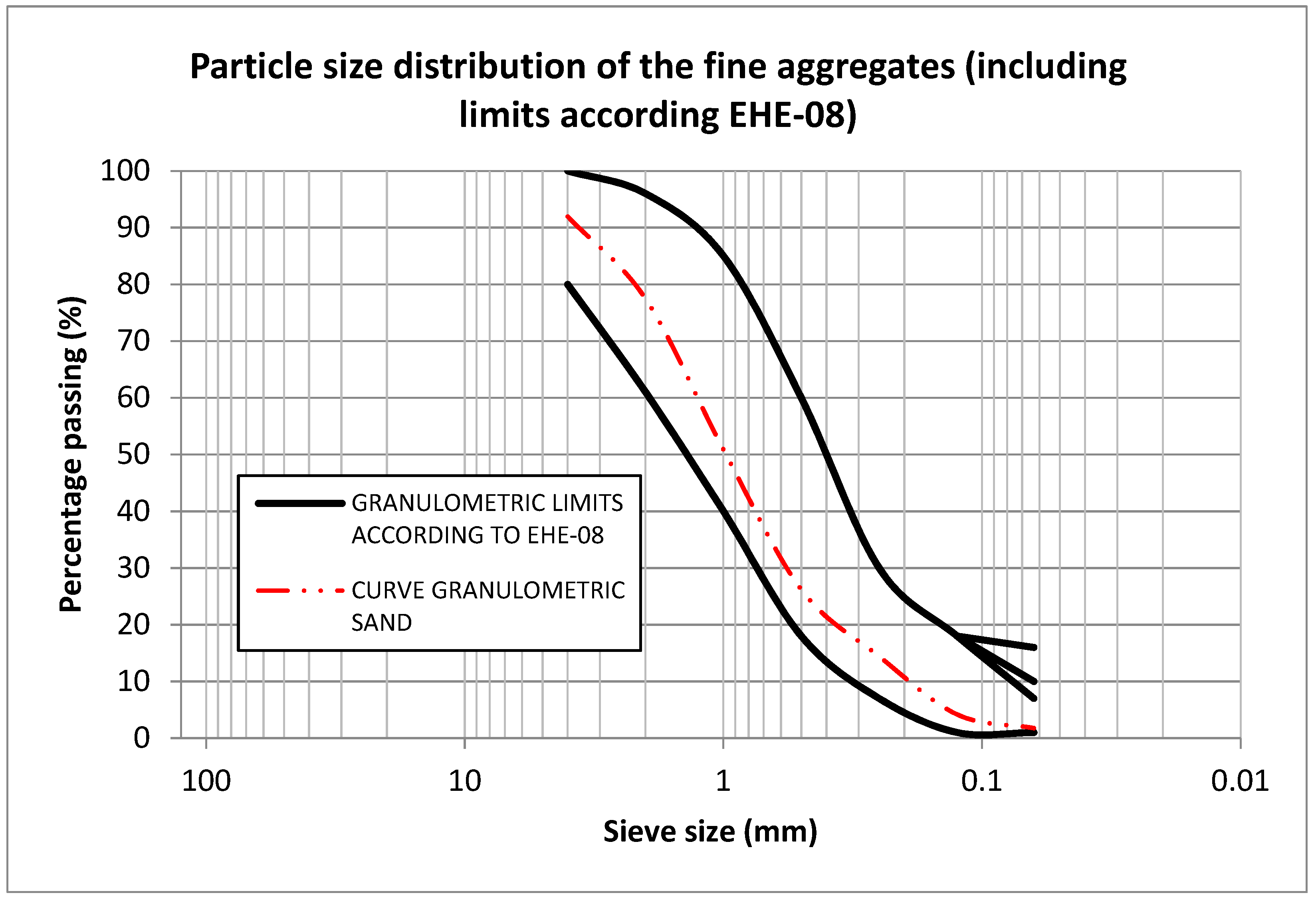
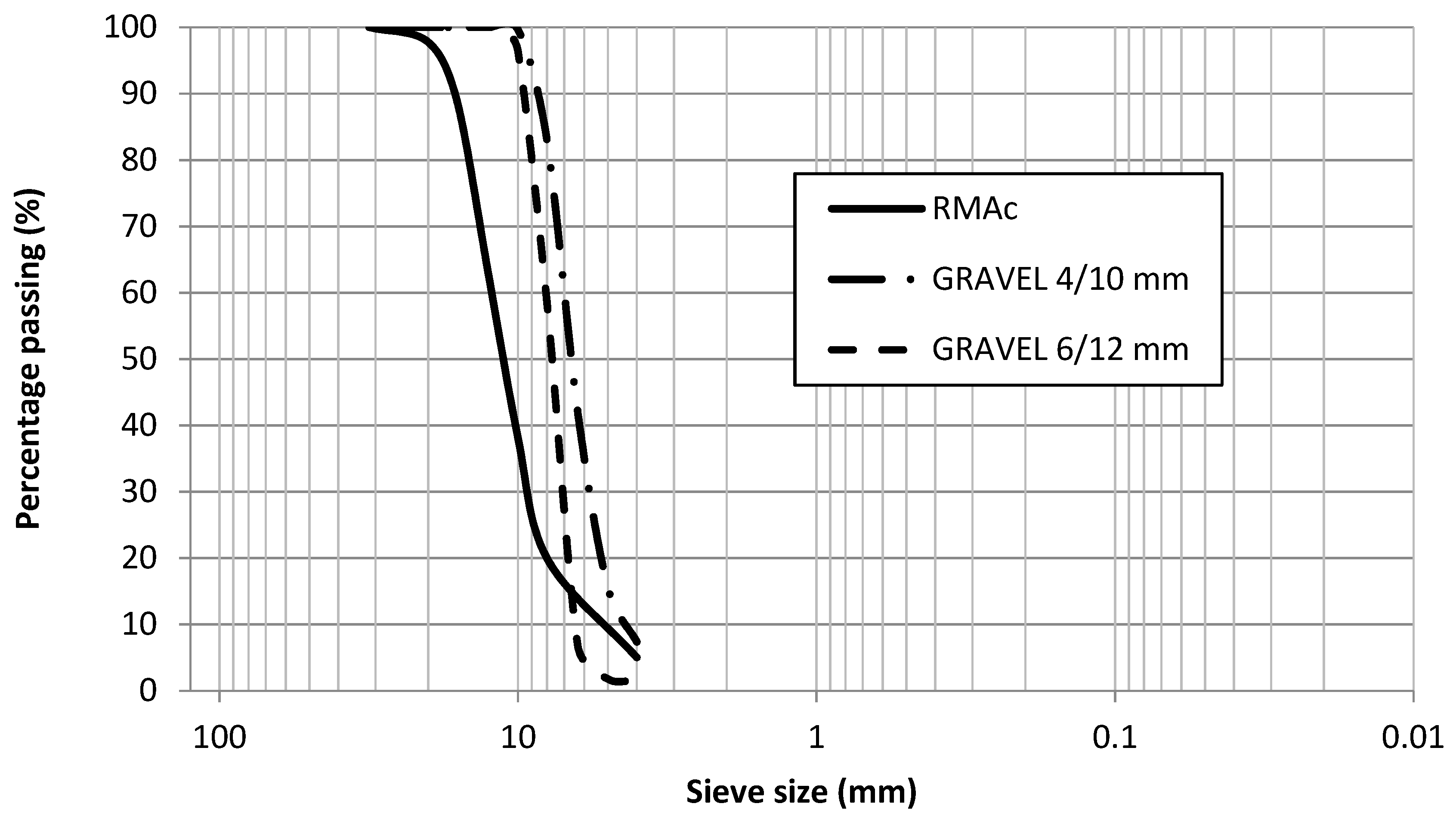


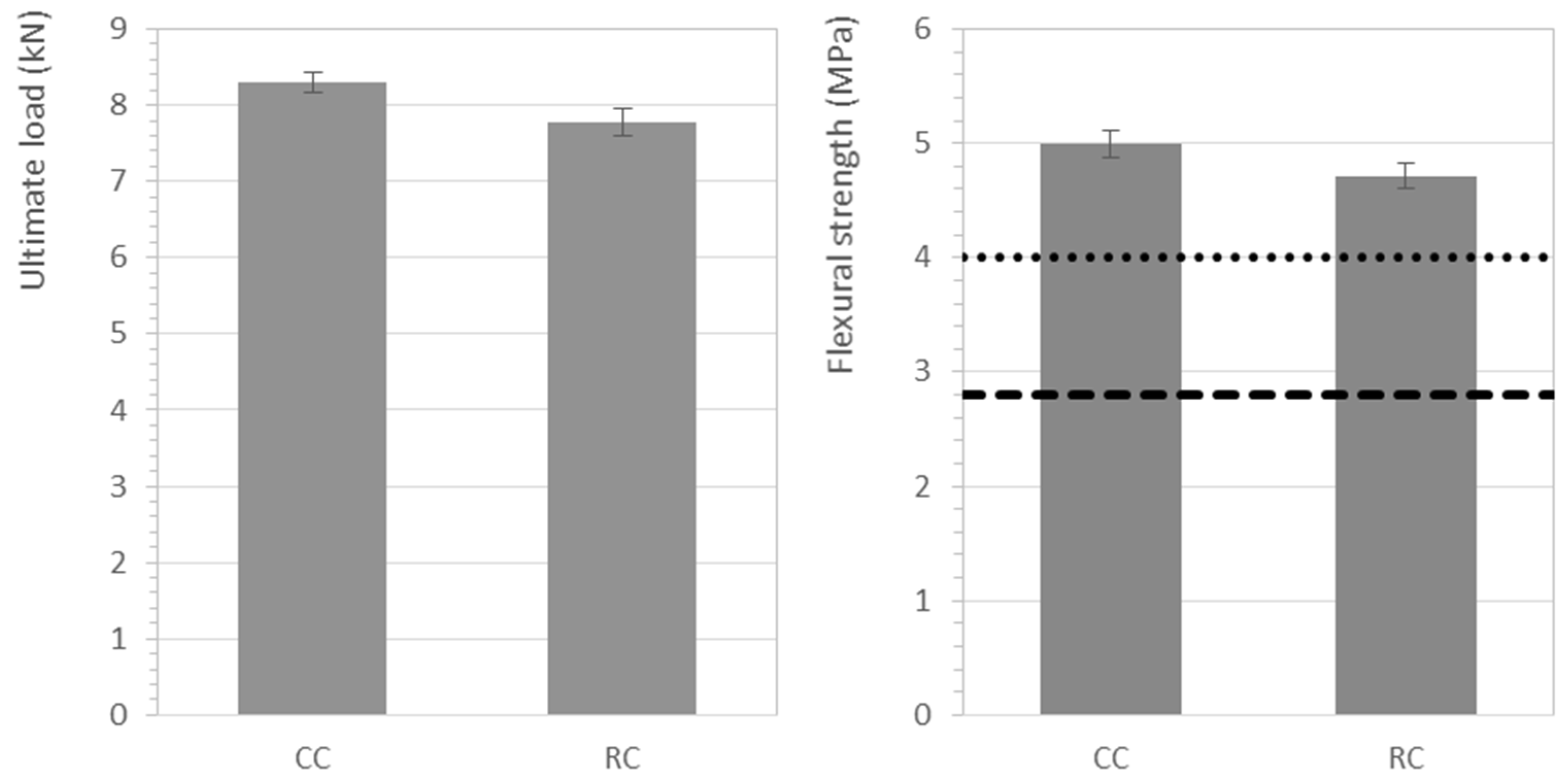



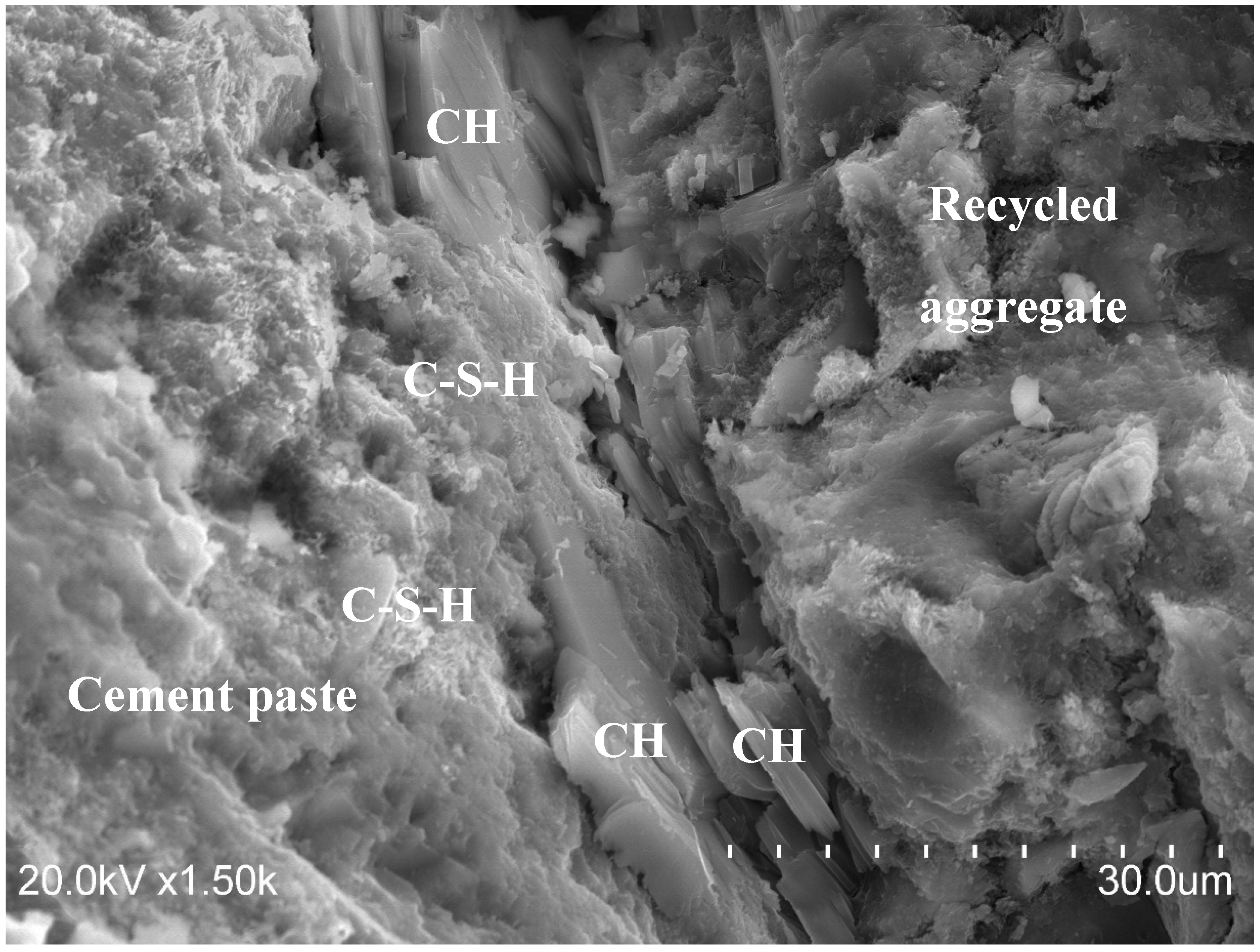
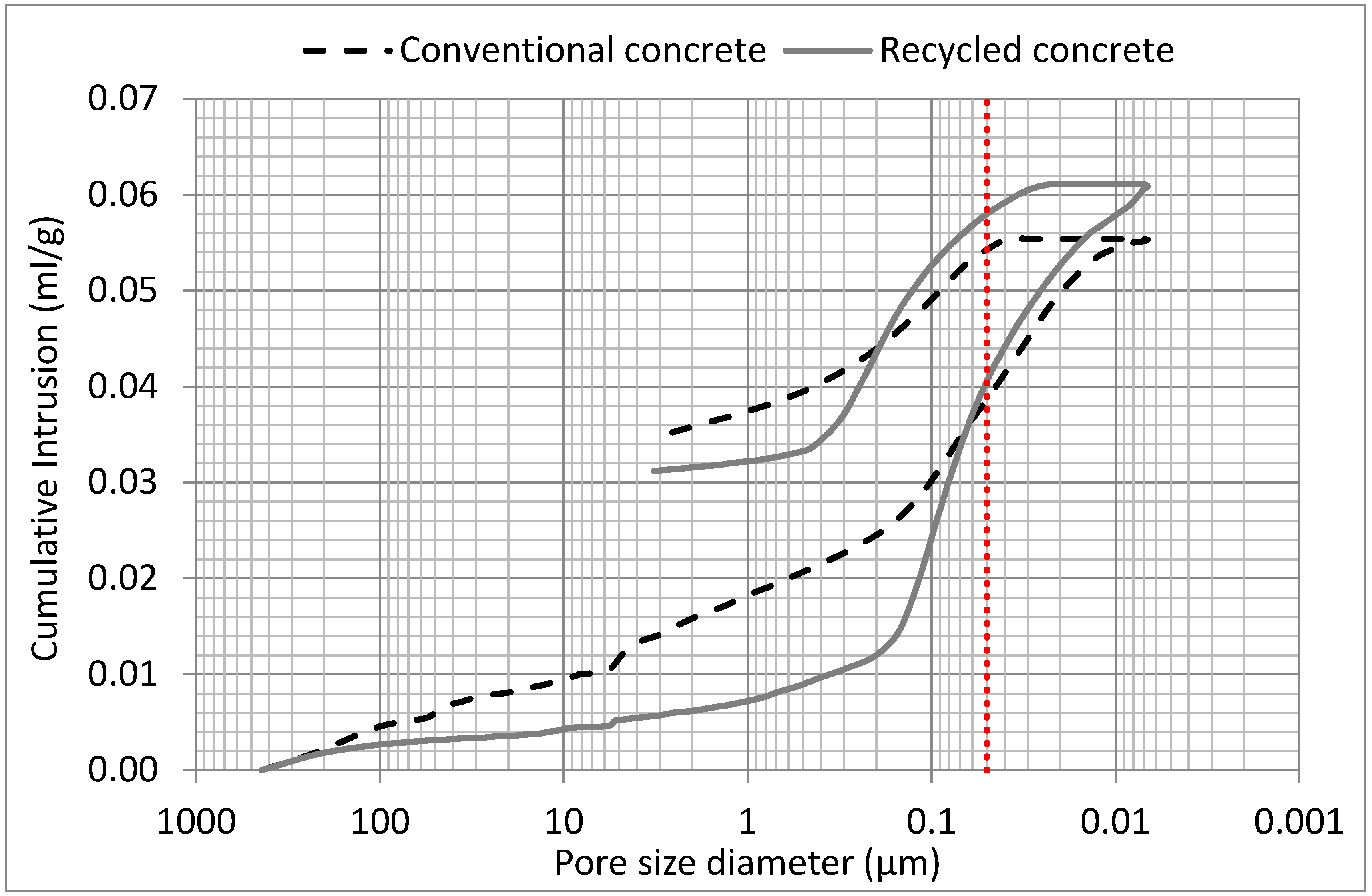

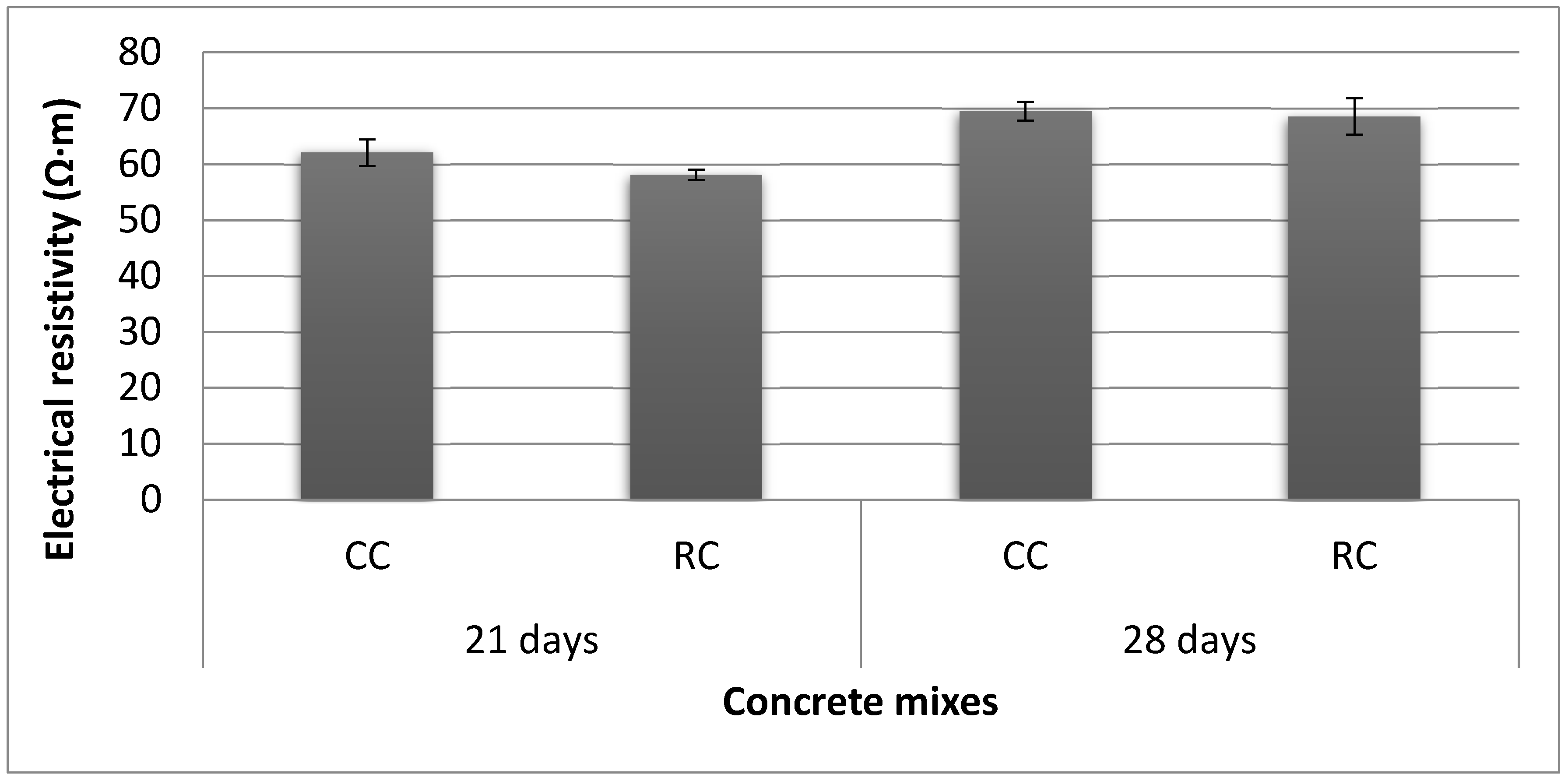
| Properties | Test Result | Limit Value | Standard Applied |
|---|---|---|---|
| Maximum particle size (mm) | 20 | - | EHE-08 (2008); EN 933-1 (2012) |
| Minimum particle size (mm) | 4 | 4 | EHE-08 (2008); EN 933-1 (2012) |
| D/d ratio | 5.0 | ≥1.4 | EHE-08 (2008); EN 933-1 (2012) |
| Granulometric modulus | 7.67 | - | UNE 7295 (1976) |
| Content of particles < 4 mm (%) | 5.03 | 5 | EHE-08 (2008) |
| Undersize particle content (%) Sieve d | 5.03 | ≤10 (EHE-08) <10 (UNE 146121) | EHE-08 (2008); UNE 146121 (2000); EN 933-1 (2012) |
| Oversize particle content (%) Sieve 2D | 0 | 0 | EHE-08 (2008); UNE 146121 (2000); EN 933-1 (2012) |
| Oversize particle content (%) Sieve D | 2.21 | <10 | EHE-08 (2008); UNE 146121 (2000); EN 933-1 (2012) |
| Fines content (%) | 0.04 | ≤1.5 (EHE-08) ≤1 (UNE 146121) | EHE-08 (2008); UNE 146121 (2000); EN 933-1 (2012) |
| Sand equivalent (SE4 or SE) | 38.10 | >70–75 (1) | EHE-08 (2008); EN 933-8 (2012) |
| Apparent density (Mg/m3) | 2.53 | - | EN 1097-6 (2014) |
| After oven-drying density (Mg/m3) | 2.08 | - | EN 1097-6 (2014) |
| Saturate surface density (Mg/m3) | 2.26 | - | EN 1097-6 (2014) |
| Water absorption (%) | 8.53 | ≤7 | EHE-08 (2008); EN 1097-6 (2014) |
| Flakiness index (%) | 14.75 | ≤35 | EHE-08 (2008); EN 933-3 (2012) |
| Los Angeles coefficient (%) | 40.99 | ≤40–50 (2) | EHE-08 (2008); EN 1097-2 (2010) |
| Components of Recycled Mixed Ceramic Aggregates (RMAc) | Percentage (wt %) |
|---|---|
| Unbound aggregates (natural aggregates without cement mortar attached) | 44.11 |
| Ceramics (bricks, tiles, stoneware and sanitary ware…) | 33.56 |
| Concrete and mortar (natural aggregates with cement mortar attached) | 17.51 |
| Asphalt | 0.44 |
| Glass | 0.75 |
| Gypsum | 3.47 |
| Other impurities (wood, paper, metals, plastic…) | 0.16 |
| Total | 100 |
| Dosification Per Cubic Meter | RC | CC |
|---|---|---|
| Total effective w/c ratio (-) | 0.50 | 0.50 |
| Water (L) | 155.21 | 155.21 |
| Cement (kg) | 312.50 | 312.50 |
| Sand 0/4 mm (kg) | 96.98 | 96.98 |
| Sand 0/5 mm (kg) | 441.81 | 441.81 |
| Gravel 4/10 mm (kg) | 242.46 | 484.92 |
| Gravel 6/12 mm (kg) | 80.82 | 161.64 |
| Recycled mixed ceramic aggregate 4/20 mm (kg) | 323.28 | - |
© 2018 by the authors. Licensee MDPI, Basel, Switzerland. This article is an open access article distributed under the terms and conditions of the Creative Commons Attribution (CC BY) license (http://creativecommons.org/licenses/by/4.0/).
Share and Cite
Juan-Valdés, A.; García-González, J.; Rodríguez-Robles, D.; Guerra-Romero, M.I.; López Gayarre, F.; De Belie, N.; Morán-del Pozo, J.M. Paving with Precast Concrete Made with Recycled Mixed Ceramic Aggregates: A Viable Technical Option for the Valorization of Construction and Demolition Wastes (CDW). Materials 2019, 12, 24. https://doi.org/10.3390/ma12010024
Juan-Valdés A, García-González J, Rodríguez-Robles D, Guerra-Romero MI, López Gayarre F, De Belie N, Morán-del Pozo JM. Paving with Precast Concrete Made with Recycled Mixed Ceramic Aggregates: A Viable Technical Option for the Valorization of Construction and Demolition Wastes (CDW). Materials. 2019; 12(1):24. https://doi.org/10.3390/ma12010024
Chicago/Turabian StyleJuan-Valdés, Andrés, Julia García-González, Desirée Rodríguez-Robles, Manuel Ignacio Guerra-Romero, Fernando López Gayarre, Nele De Belie, and Julia M. Morán-del Pozo. 2019. "Paving with Precast Concrete Made with Recycled Mixed Ceramic Aggregates: A Viable Technical Option for the Valorization of Construction and Demolition Wastes (CDW)" Materials 12, no. 1: 24. https://doi.org/10.3390/ma12010024





